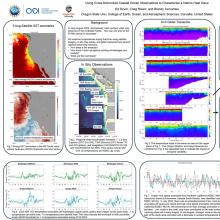Using Cross-Networked Coastal Ocean Observations to Characterize a Marine Heat Wave
Edward
Dever
Oregon State University
Poster
In summer 2023, several organizations noted anomalously warm water in the northeast Pacific prior to the oceanic El Niño signal that arrived in December 2023. We examine surface and subsurface temperatures during that time using MODIS satellite imagery, in situ time series, and glider transects from several regional observing networks. One of the key questions we address is the depth range of the anomalous high temperature observations using glider and in-situ time series data.
We focus on observations from the shelf and slope from Vancouver Island, BC, Canada to Oregon, USA. The combination of surface and subsurface observations allows us to distinguish two distinct warm anomalies in the summer of 2023 - a subsurface warming over the slope from Oregon to off of Vancouver Island that developed in May 2023, and a near surface warm anomaly that developed in August.
The two anomalies appear to have unrelated forcing mechanisms. The subsurface anomaly arrived well before the surface anomaly and persisted for at least a month after the surface anomaly ended. The surface warm anomaly that developed in early August was associated with weaker than average winds in June-July and ended as winds picked up in mid August.
The identification of these two distinct anomalies shows the benefit of having cross-networked subsurface measurements as well as satellite SST to characterize temperature extremes.
We focus on observations from the shelf and slope from Vancouver Island, BC, Canada to Oregon, USA. The combination of surface and subsurface observations allows us to distinguish two distinct warm anomalies in the summer of 2023 - a subsurface warming over the slope from Oregon to off of Vancouver Island that developed in May 2023, and a near surface warm anomaly that developed in August.
The two anomalies appear to have unrelated forcing mechanisms. The subsurface anomaly arrived well before the surface anomaly and persisted for at least a month after the surface anomaly ended. The surface warm anomaly that developed in early August was associated with weaker than average winds in June-July and ended as winds picked up in mid August.
The identification of these two distinct anomalies shows the benefit of having cross-networked subsurface measurements as well as satellite SST to characterize temperature extremes.

Poster file
dever-edward-optimizing-poster.pdf
(5.58 MB)
